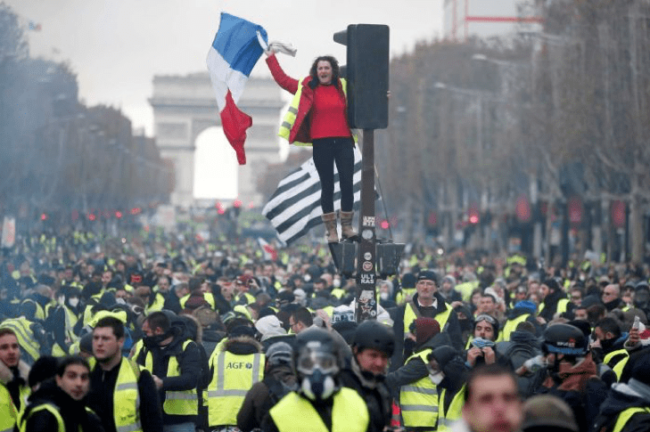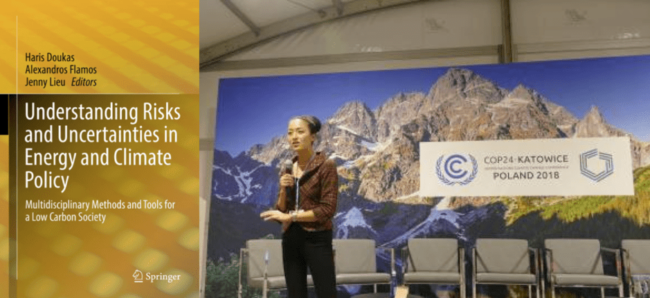Year of Publication: 2019
Author(s): Dr. Delton Chen
The IPCC (2018) special report on 1.5°C of global warming estimates that to stay below 1.5°C, manmade CO₂ emissions will need to decline by 45% by 2030 (compared to 2010), and will need to decline to zero by 2050. This extremely demanding goal has a low probability of being achieved, and would likely require industrial-scale removal of CO₂ from the atmosphere. The political feasibility of using carbon taxes to facilitate such a rapid de-carbonization is contradicted by the recent ‘Yellow Vest’ protests in France. The Yellow Vest movement rejects the notion of rising taxes on diesel fuel and austerity measures. Based on this example, what is the likelihood that politicians will impose stringent carbon taxes on fossil energy? Are taxes and regulations the only options for addressing the climate crisis? The Silver Gun Hypothesis presents a new policy option: long-term financial stimulus for the global mitigation of carbon emissions from all sectors of the economy.

About the Book
A book was recently launched at COP24, titled “Understanding Risks and Uncertainties in Energy and Climate Policy”, edited by Doukas, Flamos and Lieu. The aim of the book is to examine quantitative and qualitative methods for the design of energy and climate policies. The Silver Gun Hypothesis is featured in Chapter 8 of the book, under its technical name, the ‘Holistic Market Hypothesis’ (HMH). Chapter 8 can be downloaded for free at this link:
https://link.springer.com/content/pdf/10.1007%2F978-3-030-03152-7_8.pdf
– Springer Open Access

The Silver Gun Hypothesis
The Silver Gun Hypothesis (or Holistic Market Hypothesis) is an untested theory that a parallel carbon economy is needed to stabilize the climate system and to achieve long-term sustainability. This hypothesis is based on a biophysical analysis of positive and negative carbon pricing. A negative price is already established in various regions using carbon taxes and cap-and-trade schemes. The new positive price requires that a ‘global carbon reward’ be offered as a parallel currency to market actors in all jurisdictions and regions. A new international monetary policy is required to set the exchange rate for the parallel currency to equal the Risk Cost of Carbon (RCC) (see below).
The Silver Gun Hypothesis will be explained on the MAHB with a five-part essay:
Part II – The Entropy of Carbon
Part III – Risk and Entropy
Part IV – Money as Environmental Policy
Part V – Holistic Framework for Economic Sustainability
Hypothesis for a Risk Cost of Carbon
The Silver Gun Hypothesis proposes that the Risk Cost of Carbon (RCC) is an overlooked externalized cost, and that a historical failure to identify and address the RCC explains why our global civilization is currently unable to remain below 2°C of global warming, as requested by the Paris Climate Agreement (COP21).
The standard Social Cost of Carbon (SCC) is the externalized social cost of carbon emissions and it is used to justify the use of carbon taxes. Mainstream economists have not considered the possibility that ‘carrot and stick’ carbon prices are needed to manage the risks and costs of climate change, respectively. In the book chapter by Chen, et al., 2019, it is argued that the RCC is an externalized cost associated with the ‘systemic risk’ of global warming. The authors use the RCC to justify a ‘global carbon reward’ for managing the climate risk.
The book chapter by Chen, et al. (2019) presents an epistemological method for verifying that the SCC and RCC are complementary costs, however the book chapter does not explain how the RCC relates to Arthur Pigou’s (1920) theory for market externalities and social welfare. In Part II of the Silver Gun Hypothesis, an expanded model for externalities is presented that explains why the RCC does not appear in Pigou’s classical model for externalities.
The book chapter by Chen, et al. (2019) uses the concept of entropy—the Second Law of Thermodynamics—to verify the policies that address the SCC and RCC. The deductive approach is based on the notion that the policies for carbon taxes and carbon rewards should be time-asymmetric to maintain consistency with changing entropy. This feature of the Silver Gun Hypothesis is original; and the book chapter gives a description of the inferred time-asymmetry between the two policies, including an apparent reversal in policy objectives and market responses, as follows: (1) ‘good efficiency’ versus ‘good inefficiency’, and (2) ‘risk taking’ versus ‘risk reducing’. This time-asymmetry between the two policies results in an economic tradeoff and a theoretical solution to some major economic conundrums, including unsustainable GDP growth, Jevons paradox, and conflicts over the preferred rate of time discounting.
A shortcoming of the book chapter by Chen, et al. (2019) is that it does not explain why time-asymmetry in climate policies should manifest as (1) ‘good efficiency’ versus ‘good inefficiency’, and (2) ‘risk taking’ versus ‘risk reducing’. To further expand on this interpretation of time-asymmetry, a more general hypothesis is presented in Part II that defines the roles of efficiency/inefficiency and risk taking/reducing in the evolution of living systems.
The general hypothesis is a probabilistic macroscopic entropic theory for all living systems, including human economies. Prigogine (1978) called these systems ‘dissipative structures’ because they self-organize through energy dissipation and under conditions of thermodynamic non-equilibrium. The general hypothesis takes into consideration that such systems are carbon-based, multi-agent, and are likely to be selected for survival based on their energy efficiency and ability to manage risk.
I hope that you will join me in considering this new approach for resolving the climate crisis.
References
Chen, D.B., van der Beek, J., and Cloud, J. (2019). Hypothesis for a Risk Cost of Carbon: Revising the Externalities and Ethics of Climate Change. In: Understanding Risks and Uncertainties in Energy and Climate Policy. H. Doukas et al. (eds.). Springer Nature Switzerland AG, Cham, Switzerland. [Accessed 28 Dec. 2018]
https://link.springer.com/content/pdf/10.1007%2F978-3-030-03152-7_8.pdf
IPCC (2018). Global Warming of 1.5°C. An IPCC Special Report on the impacts of global warming of 1.5°C above pre-industrial levels and related global greenhouse gas emission pathways, in the context of strengthening the global response to the threat of climate change, sustainable development, and efforts to eradicate poverty. [Accessed 28 Dec. 2018] https://www.ipcc.ch/sr15/about/
Pigou, A. C. (1920). The Economics of Welfare. London: Macmillan.
Prigogine, I. (1978). Time, Structure, and Fluctuations. Science, 201(4358), 777–785.
About the Author
Dr. Delton B. Chen is an Australian engineer who holds a Ph.D. from the University of Queensland for his hydrogeological study of Heron Island, located in the Great Barrier Reef. Delton is a modeler/analyst in groundwater, hydrology, hot-rock energy and greenhouse mitigation, and he specialises in central bank climate policy. Delton is a co-founder of the Global 4C climate policy and is the lead developer of the Holistic Market Hypothesis (HMH), which is a new hypothesis that explains how climate risk can be priced with a Central Bank Digital Currency (CBDC).
Contact: Center for Regenerative Community Solutions, 501(c)(3) Non-Profit, NJ, USA.
Web: www.global4c.org www.crcsolutions.org and www.possibleplanet.org
Email: deltonchen@crcsolutions.org
The views and opinions expressed through the MAHB Website are those of the contributing authors and do not necessarily reflect an official position of the MAHB. The MAHB aims to share a range of perspectives and welcomes the discussions that they prompt.
